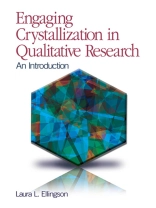‘This is the best book I have read in quite some time. Professor Ellingson writes clearly yet artfully and in a scholarly voice that is accessible to students and faculty alike. The weaving between description and illustrative case studies takes readers through the step-by-step journey of crystallization (as experienced and offered by Ellingson). The book is clearly grounded in philosophies of knowing and methods— yet, it offers practical strategies, questions, and choices for researchers.’
— Lynn M. Harter, Ohio University
Engaging Crystallization in Qualitative Research, the first ‘how to’ book to both explain and demonstrate crystallization methodology, offers a framework for blending grounded theory and other social scientific analyses with creative representations of data, such as narratives, poetry, and film. Author Laura L. Ellingson explores relevant epistemological questions that arise when crossing methodological boundaries, provides detailed steps for design and planning, offers guidelines for improving both social scientific and creative/artistic writing, and suggests strategies for targeting publication outlets for multigenre representations.
Features
- Articulates the principles of crystallization and how it enables researchers to both represent multiple perspectives on a phenomenon and highlight the partial nature of all claims of truth
- Breaks down the qualitative research barriers between the grounded theorists and those who favor artistic, interpretive, and creative approaches, exemplifying the possibilities for all
- Demonstrates the rich possibilities for blending social scientific, creative/artistic, and critical approaches to research
- Provides hands-on strategies that help practitioners and students collect, analyze, and represent qualitative data through crystallization
- Explores ethical challenges, the political nature of research findings, and the need for social justice activism among researchers
- Illustrates concepts with exemplars, featuring cutting-edge research in social sciences, education, and allied health
Suitable for experienced practitioners and advanced students of qualitative methods, Engaging Crystallization in Qualitative Research is ideal for such courses as Intermediate/Advanced Qualitative Research, Ethnographic Methods, Grounded Theory, Field Research Methods, and Qualitative Inquiry.
Daftar Isi
1. Introduction to Crystallization
Constructing Crystallization
Considering Genres
Resisting Dichotomies: A Continuum of Qualitative Methods
Principles of Crystallization
Facets of the Crystal: Types of Crystallization
Strengths of Crystallization
Limitations of Crystallization
Ethnographic Exemplars
Organization of This Book
Conclusion: Frequently Asked Questions About Crystallization
Interlude: Introducing the Author
2. Ethics and Epistemology: Assumptions Underlying Crystallization
What Is Epistemology and Why Does It Matter in Crystallization?
Making Knowledge: An Epistemological Basis for Crystallization
Voicing Other and Self: Ethics of Representation
First Do No Harm: Some Ethical Cautions
Strategies for Ethical Decision Making in Crystallization
Conclusion
Interlude: The Limits of Genre–An Exercise About Ethics and the Construction of Claims
3. Illuminating Options for Analysis and Representation Across the Continuum
Traditional Forms of Analysis
Same Old, Same Old: The Value of Traditional Qualitative Writing
Aesthetics and Analysis: Hybrids of Art and Science
Aesthetic Possibilities: Creative Analytic Practices
Conclusion
Interlude: Resisting Dichotomy, Embracing Continuum
4. Strategies for Design: Putting Crystallization Into Practice
Wondering
Weighing Your Options
Re/considering the Role of Theory
Decide on a Design
Conclusion
Interlude: Beware the Law of the Hammer
5. Bringing It All Together: Integrated Crystallization
Creating a Coherent Multigenre Text
Blending Genres and Blurring Boundaries: Woven Crystallization
Woven Crystallization Exemplars
Sharpening Edges and Separating Spaces: Patched Crystallization
Patched Crystallization Exemplars
Issues in Constructing Integrated Crystallization
Interlude: Quilting as Activism
6. All Apart: Dendritic Crystallization
Dendritic Practices
Benefits of Dendritic Crystallization
Dispersing Crystallized Findings
A Dendritic Exemplar
But Is This Really Crystallization?
Interlude: Coincidence, Synchronicity, and Putting It Out to the Universe
7. Writing Across the Continuum
Evaluating Writing and Representation
Improving your Process
Writing Well
Bag of Tricks
Conclusion
Interlude: Representing Difference
Writing Resources
8. Publishing and Promoting Crystallization
Lessons of Crystallization
Call to Action: Employing Crystallization to Promote Social Justice
Getting the World Out: Pursuing Publication
Justifying Your Work
Enclosing Wild Power: A Conclusion/Invitation
Interlude: When Your Work Is Rejected
Tentang Penulis
Laura L. Ellingson, Ph.D, is Associate Professor of Communication at Santa Clara University. Her research focuses on feminist theory and gender studies, qualitative methodology, and communication in health care organizations, including interdisciplinary communication, teamwork, and provider-patient communication. She is the author of Communicating in the Clinic: Negotiating Frontstage and Backstage Teamwork (Hampton Press) and has published articles in Health Communication, Journal of Aging Studies, Journal of Applied Communication Research, Qualitative Health Research, Women’s Studies in Communication, and Journal of Social and Personal Relationships. Currently, she is conducting an ethnography of communication in a dialysis clinic and a qualitative study of communication between aunts and their nieces/nephews.












